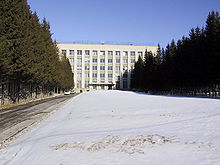Summary | Excerpt | Reviews | Beyond the Book | Read-Alikes | Genres & Themes | Author Bio

This article relates to Red Plenty
One of the most fascinating byproducts of the Russian planned economy is the academic town of Akademgorodok (Ah-kah-DYEM-gor-oh-dok) in Siberia. It is approximately 30 kilometers south of the larger Siberian city of Novosibirsk (No-VO-see-beersk), and is the setting for some of Red Plenty's most riviting stories, featuring a genetics and cytology researcher named Zoya Veynshteyn.
 Looking to populate Siberia and avoid the bureaucratic interference of Moscow, while creating a haven for the sciences at the same time, Russian premier Nikita Kruschev supported the creation of Akademgorodok (aka Academy Town) in 1958 as a part of the network of research centers known as the Soviet Academy of Sciences. Hydrodynamicist Mikhail Alexeyevich Lavrentyev, the first Chairman of the Siberian Division of the Soviet Academy of Sciences, had a strong hand in creating and shaping the educational town.
Looking to populate Siberia and avoid the bureaucratic interference of Moscow, while creating a haven for the sciences at the same time, Russian premier Nikita Kruschev supported the creation of Akademgorodok (aka Academy Town) in 1958 as a part of the network of research centers known as the Soviet Academy of Sciences. Hydrodynamicist Mikhail Alexeyevich Lavrentyev, the first Chairman of the Siberian Division of the Soviet Academy of Sciences, had a strong hand in creating and shaping the educational town.
It was around this time that traditional universities in the USSR were being replaced by technical institutes that emphasized both science and vocational skills; thousands of scientists were recruited to work in Akademgorodok's facilities. (Today it contains over thirty educational centers, including Novosibirsk State University, Budker Institute of Nuclear Physics [pictured], Sobolev Institute of Mathematics, Kutateladze Institute of Thermal Physics, and United Institute of Hydrodynamics). The theoretical and applied sciences flourished and provided the basis for many of Russia's technological advances.
 Even under a communist system, scientists in Akademgorodok received special treatment, including (relatively) larger apartments, more food rations, and access to hard-to-find groceries. However, the buildings constructed to house these scientists were especially sterile in appearance. The look was complete with the creation of a man-made beach on the banks of the Ob reservoir, made especially for the residents' relaxation - although it's difficult to imagine they do much sunning on the beach considering the highest average temperature during that part of the world's short summer is 66°F (19°C), and while Tripadvisor list a number of interesting things to do in the area, none of them involve the beach!
Even under a communist system, scientists in Akademgorodok received special treatment, including (relatively) larger apartments, more food rations, and access to hard-to-find groceries. However, the buildings constructed to house these scientists were especially sterile in appearance. The look was complete with the creation of a man-made beach on the banks of the Ob reservoir, made especially for the residents' relaxation - although it's difficult to imagine they do much sunning on the beach considering the highest average temperature during that part of the world's short summer is 66°F (19°C), and while Tripadvisor list a number of interesting things to do in the area, none of them involve the beach!
With the fall of the Soviet Union, much of Akademgordok went into decline and many scientists fell into impoverished times. Fortunately, these days the city is enjoying a revival in the wake of the 90s technology boom. Now, software programming companies, such as Novosoft, receive as much attention as the pure sciences.
Addendum: On reading this backstory, Red Plenty author Francis Spufford wrote to BookBrowse saying, "the Akademgorodok beach is still there and I saw someone emerge on to it from the chilly waters of the Ob when I was there. Russian swimmers are tough!"
Top image: aerial photo of Akademgorodok
Bottom image: The Budker Institute of Nuclear Physics in Akademgorodok
Filed under Places, Cultures & Identities
![]() This article relates to Red Plenty.
It first ran in the March 14, 2012
issue of BookBrowse Recommends.
This article relates to Red Plenty.
It first ran in the March 14, 2012
issue of BookBrowse Recommends.
The low brow and the high brow
Click Here to find out who said this, as well as discovering other famous literary quotes!
Your guide toexceptional books
BookBrowse seeks out and recommends the best in contemporary fiction and nonfiction—books that not only engage and entertain but also deepen our understanding of ourselves and the world around us.